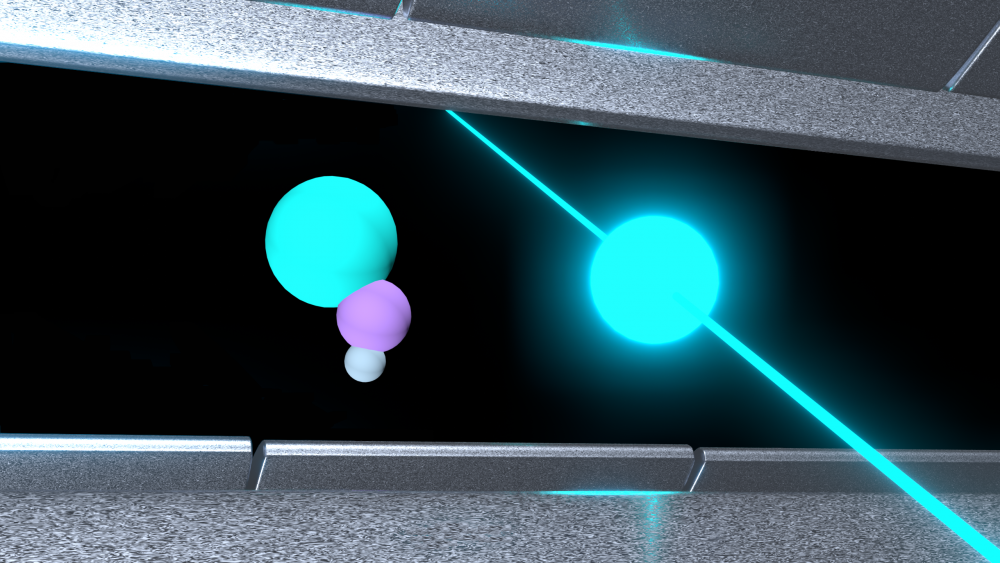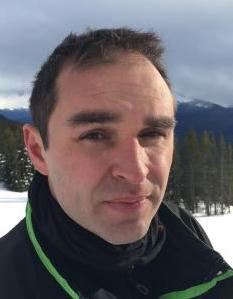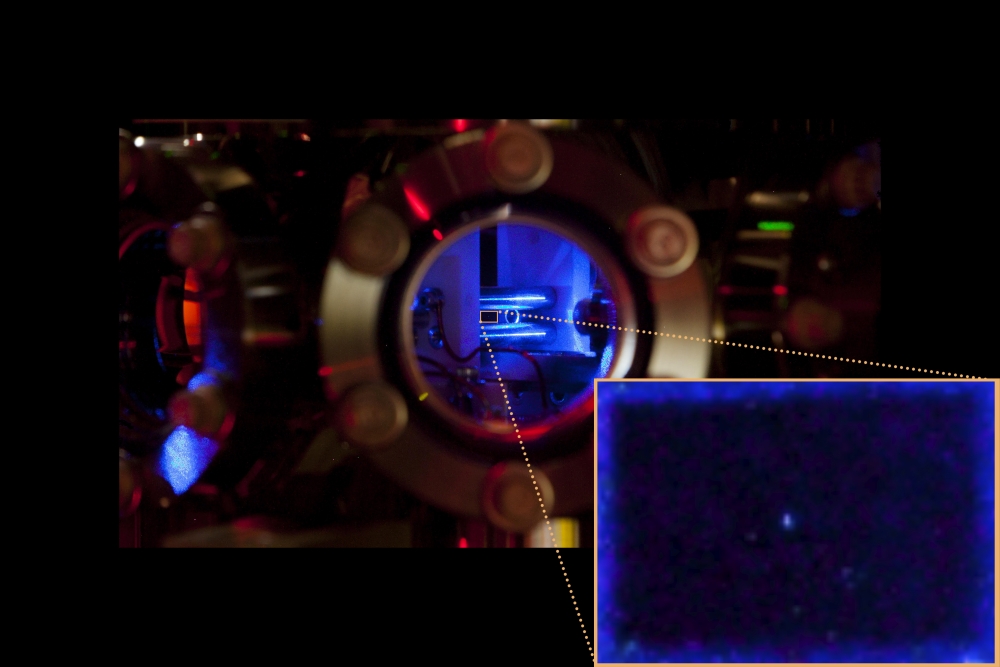
High Risk, High Rewards

It takes a lot of gumption to tackle big questions in physics, especially if you’re not enlisted in one of the small armies of researchers working at the world’s largest particle accelerators and observatories. Investigating these topics often takes expensive equipment and lots of time, both of which are easier to muster on an international project. But, UC Santa Barbara assistant professor Andrew Jayich has gumption in droves.
Jayich’s work with trapped radium molecules has earned him a prestigious National Science Foundation CAREER award as well as a $1.3 million grant from the W.M. Keck Foundation. The funds will enable him to expand his team and their equipment, making his grand experiments possible. Indeed, the group just published a paper in Physical Review Letters describing the first instance in which a radium ion was used to create a super precise optical clock.
“Andrew Jayich is an incredibly talented faculty member who richly deserves this support and recognition,” said physics department chair Claudio Campagnari. “His work with radioactive molecules promises to shed new light on fundamental symmetries and establish him as a leader in his field.”
Modern physics rests upon a foundation of conservation laws and symmetries. Take the conservation of energy, which holds that energy can neither be created nor destroyed. This tenet informs what phenomena scientists can expect and where they look for new insights. Likewise, most physics theories are built around symmetries, like positive and negative charges or north and south magnetic poles.
But there’s growing evidence that some of these symmetries aren’t ironclad. For example, physicists would initially expect that there should be equal amounts of matter and antimatter in the universe, but that is not the case.
Plan, tools and team
Jayich is focused on discovering physical phenomena where symmetry breaks down. “For instance, we need to find processes that violate time symmetry to explain the matter-antimatter asymmetry in the universe,” he said.
His team intends to use the internal structure of radioactive molecules to search for hints of new physics. In 2021, they synthesized, trapped and cooled radium molecules, clearing an early hurdle in their grand plan. Such delicate work requires laser cooling atomic ions, which in turn cool the molecular ions of interest, both of which are held in an electric trap. The group will explore properties of the very small molecule, RaH+, an effort supported by the NSF CAREER award.
The lab’s current traps operate at room temperature; however, this is insufficient for conducting spectroscopy on a polyatomic molecule, which is required for the big experiments Jayich envisions. He will use funds from the Keck grant to build a cryogenic ion trap, conduct spectroscopy on radioactive polyatomic molecules, and then use those molecules to search for time symmetry violation. Their first cryogenic trap should come online in mid-March.

Doctoral student Mingyu Fan used a long exposure to capture an image of this single radium ion contained in the team’s ion trap.
Photo Credit: MINGYU FAN
“We are very grateful to the NSF for providing the first external funding for our lab three years ago,” Jayich said, “and we are very happy to continue research with radium and radioactive molecules with their continued support through the CAREER award.”
“I'm excited to receive funding from the W.M. Keck Foundation,” he continued, “which will make it possible for our group to take large steps towards discovery.”
The group hopes to achieve record sensitivity to time symmetry violation by carefully measuring the energy difference between the radium nucleus in two different states: first when the nucleus is aligned to the molecule’s electric field, and then when it is anti-aligned. An observed difference could point toward new particles or physical interactions, or perhaps flesh out aspects of the standard model, the current leading theory in particle physics.
“A signal could be due to a part of the standard model that we’ve been trying to understand for a long time,” Jayich remarked, “or it could be a sign of new physics beyond the standard model that addresses longstanding questions about the nature of the universe.” Even if the team doesn’t detect any energy shift, their results will still help guide theorists in tackling outstanding questions about our universe.
The grants also will enable Jayich to expand the team. He plans to add a postdoctoral researcher and a new graduate student to the lab’s roster, as well as undergraduates during the summers. “UCSB physics undergraduates are amazing,” he said. “They’ve had a very strong impact on our research.”
Rapid progress
Jayich and his team have made impressive headway toward their goal. Their first result, laser cooling radium ions, came out in 2019. Not three years later they’ve used the same radioactive element to create an optical clock. The radium ion has a transition that can be driven with light over a very narrow set of frequencies. This makes it a stable reference for a laser.
“A clock is just something that counts the ticks of a regular oscillator,” Jayich noted, and a laser locked to the radium ion is a very good regular oscillator. The team was able to stabilize the frequency of a laser with the radium ion’s transition, creating an optical clock.
“The idea has been around for a long time, and has been realized with many other elements,” he said. “We’re just the first group to do it with the radium ion, which has some nice features for both transportable optical clocks and setting limits on sources of new physics.”
Jayich is proud of the lab’s turnaround time and achievement. “It highlights our ability to control the radium ion with high precision,” he said, “which is important for our work with radium molecules.” The recent paper demonstrates how quickly the team has developed techniques for working with these species.
The group plans to continue their clock work even as they prepare for more ambitious experiments. Jayich believes it could lead to a transportable optical clock. They’re also working on a long-lived radium source that can provide atoms for experiments for many, many years to come.
Big risk, big payoff
Jayich’s team is combining new ideas and new techniques into novel experiments. “We’re putting together a whole bunch of technologies — largely in the field of quantum information science, some from nuclear physics and some from precision measurement — the majority of which have come online in the roughly the last five years,” he said.
All that novelty lends the project an element of risk, but the potential payoffs are immense. He believes it’s this ambition that attracted the interest of the Keck Foundation. “There’s a large community of physicists that are desperate to understand what’s next; what’s beyond the standard model,” he said.
Buoyed by his team’s speed and productivity, Jayich has set an aggressive timeline for their research goals. He embraces the risks involved, always with an eye on the prize. “We’re investigating a little-explored area using a combination of recently developed techniques, so there are definitely risks,” he said, “but there are also a lot of opportunities along the path to our measurements on fundamental symmetries.”
Jayich credited his graduate and undergraduate students, especially Mingyu Fan, for obtaining important supporting data and working through technical aspects of the proposal. He also extended his gratitude to Nick Hutzler (Caltech) for help with radioactive molecules, as well as valuable discussions with Hutzler, Paul Hamilton (UCLA) and Jaideep Singh (MSU), and Dave Patterson and David Weld, also of UCSB. Janice Taylor, in the Office of Development at UCSB, and Andrea Stith, formerly at the Office of Research, provided significant help and guidance throughout the proposal process, Jayich said.



